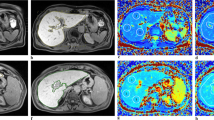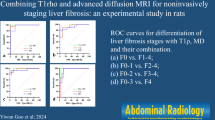Abstract
Objective
To evaluate the utility of T1 mapping on gadoxetic acid-enhanced MRI and DWI for staging liver fibrosis and assess the influence of ROI positioning on interobserver variability, T1 relaxation time and ADC value.
Methods
This retrospective study was approved by the institutional review board and included 150 patients (mean age 58 years old; 91 men and 59 women). Liver fibrosis stages (S) were histopathologically determined. T1 relaxation time and ADC value of liver were measured by three distinct ROI protocols (the whole left lobe liver, the whole right lobe liver and the individual ROIs). T1 relaxation time measurements were compared with ADC values according to S scores. Interobserver variability for the T1 relaxation times and ADC values by the three distinct ROI protocols was analyzed by calculating the ICC.
Results
T1 relaxation time measurements by the three distinct ROI protocols on severe fibrosis stage were significantly higher than the relative values on mild fibrosis stage. The mean ADC values on severe fibrosis stage showed no significantly different when measured by means of the whole right lobe liver (p = 0.057) and the individual ROIs (p = 0.10), compared with the relative values on mild fibrosis stage. AUCs of T1 relaxation time and ADC value by the means of the three distinct ROI protocols were 0.614, 0.676, 0.677 and 0.656, 0.585, 0.575 for identification of severe fibrosis stage. The interobserver reproducibility was excellent for measuring the right lobe liver T1 relaxation time and the individual ROIs T1 relaxation time (ICC 0.814, 0.883, respectively).
Conclusions
T1 relaxation time measurements by means of the three distinct ROI protocols on gadoxetic acid-enhanced MR imaging were a potential biomarker in staging of hepatic fibrosis, which were more accuracy than DWI-ADC measurements. The more reproducible results were obtained when measuring T1 relaxation time of the whole right lobe liver and the individual ROIs.

Similar content being viewed by others
References
Castera L (2011) Invasive and non-invasive methods for the assessment of fibrosis and disease progression in chronic liver disease. Best Pract Res Clin Gastroenterol 25:291–303
Hu Y, Gong HY, Lin HJ (2015) Real-time tissue elastography for assessment of liver stiffness in adults without known liver disease. J Ultrasound Med Sep 18. pii: 14.10001. (Epub ahead of print)
Nakayama H, Takayama T (2015) Management before hepatectomy for hepatocellular carcinoma with cirrhosis. World J Hepatol 7:2292–2302
Robert S, Indra NG (2014) Non-invasive monitoring of liver fibrosis. Br Med Bull 112:97–106
Bedossa P, Carrat F (2009) Liver biopsy: the best, not the gold standard. J Hepatol 50:1–3
Castera L (2008) Assessing liver fibrosis. Gastroenterol Hepatol 2:541–552
Rockey DC, Caldwell SH, Goodman ZD et al (2009) Liver biopsy. Hepatology 49:1017–1044
Ichikawa S, Motosugi U, Morisaka H et al (2015) Comparison of the diagnostic accuracies of magnetic resonance elastography and transient elastography for hepatic fibrosis. Magn Reson Imaging 33:26–30
Castera L, Negre I, Samii K, Buffet C (2001) Patient-administered nitrous oxide/oxygen inhalation provides safe and effective analgesia for percutaneous liver biopsy: a randomized placebo-controlled trial. Am J Gastroenterol 96:1553–1557
Aube C (2015) Imaging modalities for the diagnosis of hepatic fibrosis and cirrhosis. Clin Res Hepatol Gastroenterol 39:38–44
Lucidarme D, Foucher J, Le Bail B et al (2009) Factors of accuracy of transient elastography (fibroscan) for the diagnosis of liver fibrosis in chronic hepatitis C. Hepatology 49:1083–1089
Castéra L, Vergniol J, Foucher J et al (2005) Prospective comparison of transient elastography, fibrotest, APRI, and liver biopsy for the assessment of fibrosis in chronic hepatitis C. Gastroenterology 128:343–350
Bohte AE, de Niet A, Jansen L et al (2014) Non-invasive evaluation of liver fibrosis: a comparison of ultrasound-based transient elastography and MR elastography in patients with viral hepatitis B and C. Eur Radiol 24:638–648
Tokgoz O, Unal I, Turgut GG et al (2014) The value of liver and spleen ADC measurements in the diagnosis and follow up of hepatic fibrosis in chronic liver disease. Acta Clin Belg 69:426–432
Rihyeon K, Jeong ML, Cheong S et al (2015) Differentiation of intrahepatic mass-forming cholangiocarcimona from hepatocellular carcinoma on gadoxetic acid-enhanced liver MR imaging. Eur Radiol. doi:10.1007/s00330-015-4005-8
Haimerl M, Wachtler M, Platzek I et al (2013) Added value of Gd-EOB-DTPA-enhanced Hepatobiliary phase MR imaging in evaluation of focal solid hepatic lesions. BMC Med Imaging 13:41
Saito K, Ledsam J, Sourbron S et al (2014) Measuring hepatic functional reserve using low temporal resolution Gd-EOB-DTPA dynamic contrast-enhanced MRI: a preliminary study comparing galactosyl human serum albumin scintigraphy with indocyanine green retention. Eur Radiol 24:112–119
Jang YJ, Cho SH, Bae JH et al (2013) Noninvasive assessment of hepatic fibrosis using gadoxetate-disodium-enhanced 3T MRI. Ann Hepatol 12:926–934
Ding Y, Rao SX, Chen CZ et al (2015) Liver fibrosis staging using T1 mapping on Gadoxetic acid-enhanced MR imaging compared with DW imaging. Clin Radiol 70:1096–1103
Tsuda N, Okada M, Murakami T (2010) New proposal for the staging of nonalcoholic steatohepatitis: evaluation of liver fibrosis on Gd-EOB-DTPA-enhanced MRI. Eur J Radiol 73:137–142
Watanabe H, Kanematsu M, Goshima S et al (2011) Staging hepatic fibrosis: comparison of gadoxetate disodium-enhanced and diffusion-weighted MR imaging—preliminary observations. Radiology 259:142–150
Lagadec M, Doblas S, Giraudeau C et al (2015) Advanced fibrosis: correlation between pharmacokinetic parameters at dynamic gadoxetate-enhanced MR imaging and hepatocyte organic anion transporter expression in rat liver. Radiology 274:379–386
Bae KE, Kim SY, Lee SS et al (2012) Assessment of hepatic function with Gd-EOB-DTPA-enhanced hepatic MRI. Dig Dis 30:617–622
Yoshimura N, Saito K, Saguchi T et al (2013) Distinguishing hepatic hemangiomas from metastatic tumors using T1 mapping on gadoxetic-acid-enhanced MRI. Magn Reson Imaging 31:23–27
Marzi S, Stefanetti L, Seperati F et al (2015) Relationship between diffusion parameters derived from intravoxel incoherent motion MRI and perfusion measured by dynamic contrast-enhanced MRI of soft tissue tumors. NMR Biomed. doi:10.1002/nbm.3446
Acknowledgments
This study was funded by the Youth Program on Shanghai Municipal Commission of Health and Family Planning (Grant No. 20154Y0009).
Author information
Authors and Affiliations
Corresponding author
Ethics declarations
Conflict of interest
There is no any conflict of interest information for all authors.
Ethical statement
All procedures performed in studies involving human participants were in accordance with the ethical standards of the institutional. This retrospective study was approved by Institutional Review Board of our hospital and the requirement for informed consent was waived.
Rights and permissions
About this article
Cite this article
Ding, Y., Rao, S., Yang, L. et al. Comparison of the effect of region-of-interest methods using gadoxetic acid-enhanced MR imaging with diffusion-weighted imaging on staging hepatic fibrosis. Radiol med 121, 821–827 (2016). https://doi.org/10.1007/s11547-016-0669-7
Received:
Accepted:
Published:
Issue Date:
DOI: https://doi.org/10.1007/s11547-016-0669-7




